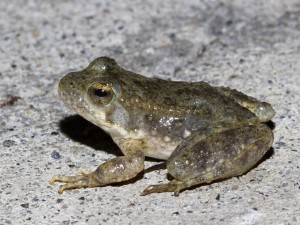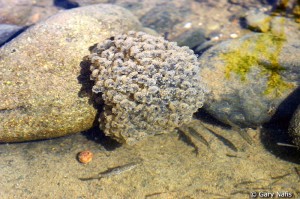Rana boylii
- Endangered – Endangered Species Act
- Sensitive Species – U.S. Forest Service
- Species of Special Concern – California Department of Fish and Wildlife
- Near Threatened – IUCN Red List (2004)
- G3 Vulnerable – NatureServe (2001)

The foothill yellow-legged frog (FYLF) was once widespread throughout the streams and rivers of the Los Padres National Forest, but today has been reduced to scattered populations in Monterey County. All southern FYLF populations have been extirpated, and the frog may disappear from the forest completely unless urgent steps are taken to identify and protect its habitat.
The frog historically occurred from western Oregon south through the San Gabriel Mountains in Los Angeles County. Its habitat consists of streams and rivers within foothill drainages, and as its name implies, its legs and lower abdomen have a notable yellowish color.
Adult FYLFs are between 1.5 and 3.5 inches long and have varied colored patterns that include a mottled mix of gray, brown, and green. They feed on a variety of both aquatic and terrestrial insects. The primary natural predator of the FYLF is the garter snake which preys on both adult and young frogs.
The FYLF uses slow-flowing streams and rivers to lay its egg clusters during the spring months after the flow from the winter storms has settled. The frogs can lay up to 1,200 eggs each! After hatching, the tadpoles typically stay around the location of the egg cluster. After metamorphosis, which typically takes 3-4 months, the juvenile frogs make their way upstream from the hatching site. The FYLF is one of the most poorly-known frog species in California, as no detailed study of its life history has ever been undertaken.
The calls of the FYLF are rarely heard as the frog’s vocal sacs are very small and produce only a faint call. This along with noisy running water where they are typically found make it difficult to hear them. You can listen to the call of the foothill yellow-legged frog here. They call mostly underwater, where the sound of even the FYLF’s faint call carries more easily.
Threats

The FYLF population has become dramatically reduced over the past half century and now only inhabits a fraction of its original range. The FYLF is no longer found south of Monterey County. The remaining populations are scattered in northern California with an isolated population nearing extirpation in the southern Sierra Nevada.
Historically, the FYLF was found in the coastal drainages in Santa Barbara County and the northern Los Padres, but has not been seen in this area for several decades. There are several historic locations in the southern portion of the Los Padres National Forest; including Piru Creek, Sespe Creek, Hopper Creek, Santa Paula Canyon, upper Santa Ynez River, upper Indian Creek, and Santa Cruz Creek. The last reliable observation of a foothill yellow-legged frog in the region occurred near Frenchman’s Flat along Piru Creek in 1977.
Scientists are unsure what exactly caused the frog’s decline, but a major storm event in 1969 may have been a factor in the frog’s extirpation from the southern extent of its range. The FYLF is highly susceptible to high streamflows and fast-moving water because all stages of their life cycle are dependent on slow-flowing streams and rivers. Artificial releases of large amounts of water from dams and reservoirs may have also played a role in eliminating the FYLF from the southern portion of its range.
Other factors that negatively affect FYLF include pesticides from agricultural practices, introduced predator species such as bullfrogs (particularly those that eat frog eggs and tadpoles), disease, habitat loss, and trampling and sedimentation by livestock and recreationists along streams.
Conservation
In 1994, what was then the California Department of Fish and Game (which later became the California Department of Fish and Wildlife) classified the FYLF as a “Species of Special Concern” due to the continued threats facing the species. The U.S. Forest Service also considers the FYLF as a “Sensitive Species,” requiring special management consideration when proposing activities in its habitat on national forest land.

In July 2012, the Center for Biological Diversity submitted a petition to the U.S. Fish and Wildlife Service to add the FYLF to the federal endangered species list. Eleven years later, the Service officially classified the south coast populations of the frog (from Monterey to Los Angeles counties) as endangered in 2023.
According to the Forest Service, further surveys are needed to determine the full extent of foothill yellow-legged populations on the northern Los Padres National Forest. This will ensure that their remaining habitat is identified and protected.







